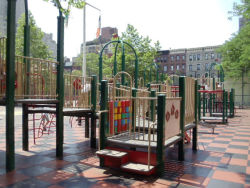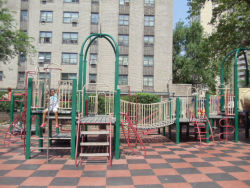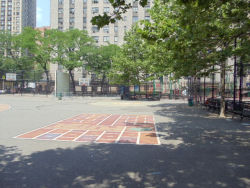Sol Bloom Playground
Sol Bloom Playground
What was here before?
Flemish and Dutch settlers of the late 17th century called this region Bloemendaal, meaning “flowering valley.” During the early 19th century, small villages developed among the country estates of the wealthy. This site was once part of the Apthorp Estate, which was built by Charles Ward Apthorp Jr. (1729-1797), a prosperous loyalist merchant who traded in dry goods and enslaved peoples. Most of his wealth and properties throughout the Northeast were confiscated after the American Revolutionary War.
In the mid-nineteenth century, the mansion was converted into an inn and the grounds were developed as a beer garden and picnic areas called Elm Park. This was the site of the first Orange Riots in 1870 between the Irish Protestants and Irish Catholics. The building was demolished in 1891.
At the turn of the century, cultural institutions, residential hotels, apartment buildings, mansions, rowhouses, and tenements rose on the Upper West Side with row houses being on this property.
The Westside Renewal Project which began in 1955, replaced old buildings with new construction such as large housing complexes and cultural institutions, as well as schools and playgrounds including this one.
How did this site become a playground?
This playground is a Jointly Operated Playground (JOP) serving P.S. 84 (The Lillian Weber School) and the local community. Beginning in 1938, the Board of Education (now the Department of Education) agreed to provide land next to schools where NYC Parks could build and maintain playgrounds that could be used by the school during the day and by the public when school is not in session. Lillian Weber (1917-1994) was a pioneer in Open Corridor education and worked at the neighboring school that was later named in her honor.
Renovation of the park took place in 1997 and included the installation of new play structures, baseball and basketball play areas, game tables, and trees. Unique features include cast iron sunflower rosettes, a freestanding panel depicting animals from Frank Baum’s classic story The Wizard of Oz (1900), a colorful sundial, and a sunflower spray shower.
How did this playground get its name?
Sol Bloom (1870-1949) was a self-made man who rose from poverty to become a distinguished businessman and public servant.
Bloom was the son of Polish-Jewish immigrants and had no formal education. Originally from Illinois, the family moved to San Francisco where he first worked in a factory, then in the entertainment industry, and eventually in the import business. His lucrative music publishing company brought him to New York in 1903. Seven years later, Bloom had a successful real estate venture, building apartment houses and what would become some of Manhattan’s most famous theaters, including the Apollo, Harris, and Music Box theaters.
In 1923 Bloom was elected to the House of Representatives, beginning the first of his fourteen consecutive terms. Bloom focused his efforts on social issues, such as the passage of more lenient immigration laws, and supported most New Deal legislation. After being appointed chairman of the House Foreign Affairs Committee in 1940, Bloom developed critical legislation addressing armament, universal service, and aid to foreign countries. He helped write the United Nations charter in 1945 and ardently supported the creation of a Jewish state. Sol Bloom died in 1949.
Check out your park's Vital Signs
Clean & Safe
Green & Resilient
Empowered & Engaged Users
Share your feedback or learn more about how this park is part of a
Vital Park System






